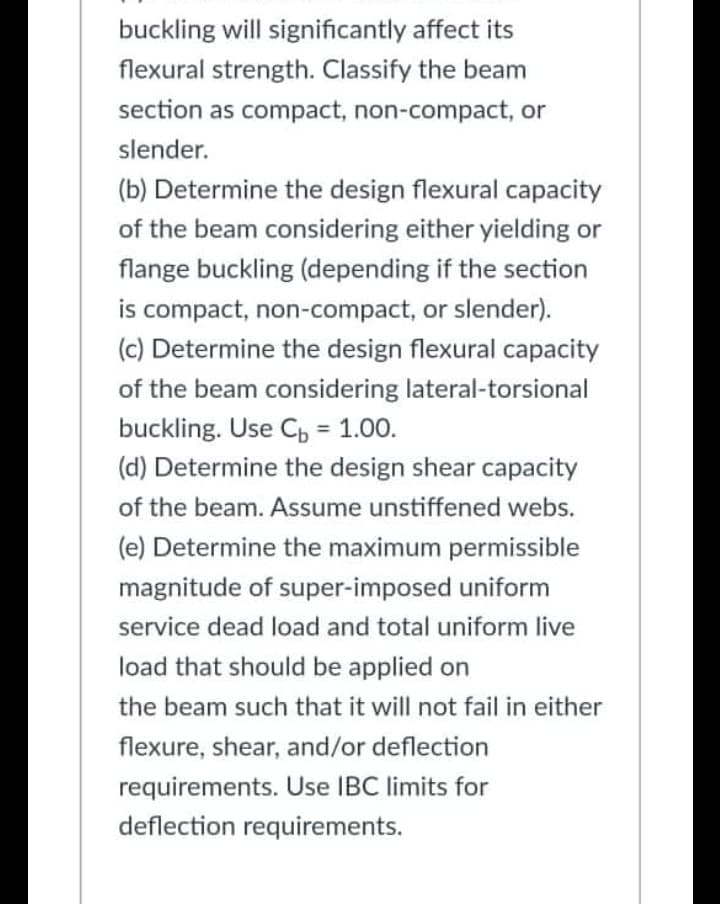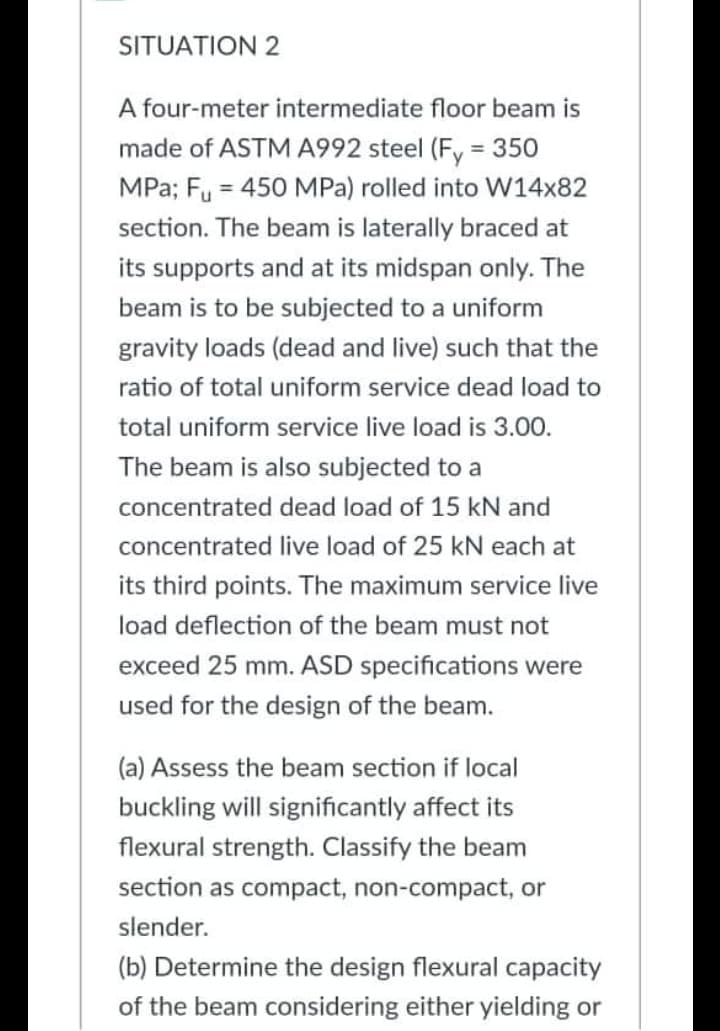A four-meter intermediate floor beam is made of ASTM A992 steel (Fy = 350 MPa; F₁ = 450 MPa) rolled into W14x82 section. The beam is laterally braced at its supports and at its midspan only. The beam is to be subjected to a uniform gravity loads (dead and live) such that the ratio of total uniform service dead load to total uniform service live load is 3.00. The beam is also subjected to a concentrated dead load of 15 kN and concentrated live load of 25 kN each at its third points. The maximum service live load deflection of the beam must not exceed 25 mm. ASD specifications were used for the design of the beam.
A four-meter intermediate floor beam is made of ASTM A992 steel (Fy = 350 MPa; F₁ = 450 MPa) rolled into W14x82 section. The beam is laterally braced at its supports and at its midspan only. The beam is to be subjected to a uniform gravity loads (dead and live) such that the ratio of total uniform service dead load to total uniform service live load is 3.00. The beam is also subjected to a concentrated dead load of 15 kN and concentrated live load of 25 kN each at its third points. The maximum service live load deflection of the beam must not exceed 25 mm. ASD specifications were used for the design of the beam.
Steel Design (Activate Learning with these NEW titles from Engineering!)
6th Edition
ISBN:9781337094740
Author:Segui, William T.
Publisher:Segui, William T.
Chapter10: Plate Girders
Section: Chapter Questions
Problem 10.7.8P
Related questions
Question
help me i got trouble on this igive you upvote :))

Transcribed Image Text:buckling will significantly affect its
flexural strength. Classify the beam
section as compact, non-compact, or
slender.
(b) Determine the design flexural capacity
of the beam considering either yielding or
flange buckling (depending if the section
is compact, non-compact, or slender).
(c) Determine the design flexural capacity
of the beam considering lateral-torsional
buckling. Use C, = 1.00.
(d) Determine the design shear capacity
of the beam. Assume unstiffened webs.
(e) Determine the maximum permissible
magnitude of super-imposed uniform
service dead load and total uniform live
load that should be applied on
the beam such that it will not fail in either
flexure, shear, and/or deflection
requirements. Use IBC limits for
deflection requirements.

Transcribed Image Text:SITUATION 2
A four-meter intermediate floor beam is
made of ASTM A992 steel (Fy = 350
MPa; Fu = 450 MPa) rolled into W14x82
section. The beam is laterally braced at
its supports and at its midspan only. The
beam is to be subjected to a uniform
gravity loads (dead and live) such that the
ratio of total uniform service dead load to
total uniform service live load is 3.00.
The beam is also subjected to a
concentrated dead load of 15 kN and
concentrated live load of 25 kN each at
its third points. The maximum service live
load deflection of the beam must not
exceed 25 mm. ASD specifications were
used for the design of the beam.
(a) Assess the beam section if local
buckling will significantly affect its
flexural strength. Classify the beam
section as compact, non-compact, or
slender.
(b) Determine the design flexural capacity
of the beam considering either yielding or
Expert Solution
This question has been solved!
Explore an expertly crafted, step-by-step solution for a thorough understanding of key concepts.
Step by step
Solved in 7 steps with 1 images

Knowledge Booster
Learn more about
Need a deep-dive on the concept behind this application? Look no further. Learn more about this topic, civil-engineering and related others by exploring similar questions and additional content below.Recommended textbooks for you

Steel Design (Activate Learning with these NEW ti…
Civil Engineering
ISBN:
9781337094740
Author:
Segui, William T.
Publisher:
Cengage Learning

Steel Design (Activate Learning with these NEW ti…
Civil Engineering
ISBN:
9781337094740
Author:
Segui, William T.
Publisher:
Cengage Learning